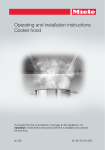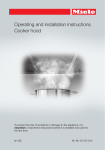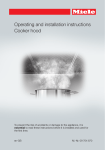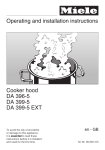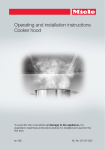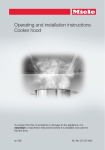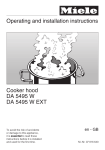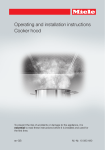Download Miele DA 5496 W EXT Technical data
Transcript
Operating and installation instructions Cooker hood DA 5496 W DA 5496 W EXT en-HK To avoid the risk of accidents or damage to the appliance, it is essential to read these instructions before it is installed and used for the first time. M.-Nr. 09 783 630 Contents Warning and Safety instructions.......................................................................... 3 Caring for the environment................................................................................. 12 Modes of operation.............................................................................................. 13 Guide to the appliance......................................................................................... 14 Operation.............................................................................................................. Switching the fan on.............................................................................................. Selecting the power level....................................................................................... Switching the fan off.............................................................................................. Switching the hob lighting on / off......................................................................... Safety switch-off.................................................................................................... 16 16 16 17 17 17 Cleaning and care................................................................................................ Housing.................................................................................................................. Important for appliances with glass surfaces................................................... Grease filters.......................................................................................................... Charcoal filter......................................................................................................... Disposing of the charcoal filter......................................................................... Changing a halogen lamp...................................................................................... 18 18 19 19 21 21 22 Installation............................................................................................................ Before installation.................................................................................................. Protective foil......................................................................................................... Installation instructions.......................................................................................... Dismantling............................................................................................................ Assembly parts...................................................................................................... Appliance dimensions............................................................................................ Safety distance between hob and cooker hood.................................................... Installation recommendations................................................................................ Drilling diagram for wall mounting......................................................................... 23 23 23 23 23 24 26 27 28 28 Connection for air extraction.............................................................................. 29 Condensate trap.................................................................................................... 30 Silencer.................................................................................................................. 30 Electrical connection........................................................................................... 32 After Sales / Guarantee....................................................................................... 33 Position of the data plate....................................................................................... 33 Technical data...................................................................................................... 34 2 Warning and Safety instructions This appliance complies with all relevant local and national safety requirements. Inappropriate use can, however, lead to personal injury and damage to property. To avoid the risk of accidents and damage to the appliance, please read these instructions carefully before using it for the first time. They contain important notes on the safety, installation, use and maintenance of the appliance. Miele cannot be held liable for non-compliance with these instructions. Keep these instructions in a safe place and ensure that all users are familiar with the contents. Pass them on to any future owner of the appliance. Correct application This cooker hood is intended for use in domestic households and similar working and residential environments. The cooker hood is not intended for outdoor use. It must only be used as a domestic appliance to extract vapours and remove odours from cooking. Any other usage is not supported by the manufacturer and could be dangerous. The cooker hood can only be used by people with reduced physical, sensory or mental capabilities, or lack of experience and knowledge, if they are supervised whilst using it, or have been shown how to use it in a safe way and recognise and understand the consequences of incorrect operation. Safety with children Children under 8 years of age must be kept away from the cooker hood unless they are constantly supervised. Children 8 years and older may only use the cooker hood unsupervised if they have been shown how to use it safely and recognise and understand the consequences of incorrect operation. 3 Warning and Safety instructions Children must not be allowed to clean or maintain the cooker hood unsupervised. Please supervise children in the vicinity of the cooker hood and do not let them play with it. Danger of suffocation. Packaging, e.g. plastic wrappings, must be kept out of the reach of babies and children. Whilst playing, children could become entangled in packaging or pull it over their head and suffocate. 4 Warning and Safety instructions Technical safety Unauthorised installation, maintenance and repairs can cause considerable danger for the user. Installation, maintenance and repairs must only be carried out by a Miele authorised technician. A damaged appliance can be dangerous. Check it for visible signs of damage. Do not use a damaged appliance. The electrical safety of this appliance can only be guaranteed when correctly earthed. It is essential that this standard safety requirement is met. If in any doubt please have the electrical installation tested by a qualified electrician. Before connecting the appliance to the mains supply, ensure that the connection data on the data plate (voltage and frequency) match the mains electricity supply. This data must correspond in order to avoid the risk of damage to the appliance. Consult a qualified electrician if in any doubt. Do not connect the appliance to the mains electricity supply by a multi-socket unit or an extension lead. Extension leads are a fire hazard and do not guarantee the required safety of the appliance. For appliances with an external motor fitted (...EXT models) the connection of the two units must be made using the connection cable and the plug connectors. These models may only be combined with a Miele external motor. 5 Warning and Safety instructions For safety reasons, this appliance may only be used after it has been built in. The cooker hood must not be used in a non-stationary location (e.g. on a ship). Tampering with electrical connections or components and mechanical parts is highly dangerous to the user and can cause operational faults. Only open the housing as described in the instructions given in the installation sheet and in the Cleaning and care section of this booklet. Under no circumstances should any other parts of the housing be opened. The manufacturer's warranty will be invalidated if the appliance is not repaired by a Miele approved service technician. Miele can only guarantee the safety of the appliance when genuine original Miele replacement parts are used. Faulty components must only be replaced by Miele spare parts. If the electrical connection cable is faulty it must only be replaced by a Miele authorised service technician to protect the user from danger. During installation, maintenance and repair work, the appliance must be disconnected from the mains electricity supply. 6 Warning and Safety instructions Using at the same time as other heating appliances that depend on the air from the room Warning - danger of toxic fumes Great care should be taken when using the cooker hood at the same time and in the same room or area of the house as another heating appliance which depends on the air in the room. Such appliances include gas, oil, wood or coal-fired boilers and heaters, continuous flow or other water heaters, gas hobs, cookers or ovens which draw air in from the room and duct exhaust gases out through a chimney or extraction ducting. When used in extraction mode, with or without an external motor fitted, or in recirculation mode with a recirculation box installed outside the room, the appliance draws air in from the room in which it is installed and from neighbouring rooms. If there is insufficient air, an underpressure will occur. The heating appliance will be starved of oxygen, impairing combustion. Harmful gases could be drawn out of the chimney or extraction ducting back into the room, with potentially fatal consequences. 7 Warning and Safety instructions In order to ensure safe operation, and to prevent gases given off by the heating appliances from being drawn back into the room when the cooker hood and the heater are in operation simultaneously, an underpressure in the room of 0.04 mbar (4 pa) is the maximum permissible. Ventilation can be maintained by air inlets which cannot be blocked, in windows, doors or outside wall vents, or by other technical measures, such as ensuring that the cooker hood can only be switched on when the heating appliance is switched off or vice versa. A ventilation brick alone is not generally sufficient to ensure safe ventilation. The overall ventilation condition of the dwelling must be taken into account. If in any doubt, the advice of a competent builder or, for gas a qualified gas fitter (registered with an official gas safety body in accordance with national safety regulations, GasSafe in the UK) must be sought. The cooker hood must not be used in recirculation mode, where the air is directed back into the room where it is located, at the same time as a heating appliance which depends on the room air. 8 Warning and Safety instructions Correct use Never use an open flame beneath the cooker hood. To avoid the danger of fire, do not flambé or grill over an open flame. When switched on, the cooker hood could draw flames into the filter. Fat deposits could ignite, presenting a fire hazard. The cooker hood can become damaged when exposed to excessive heat. – When using the cooker hood over a gas hob, ensure that any burners in use are always covered by a pan. Switch the cooking zone off when a pan is removed, even for a short time. – Select a pan which is suitable for the size of the burner. – Regulate the flame so that it does not burn up the sides of the pan. – Avoid overheating the pan (e.g., when cooking with a wok). Always switch the cooker hood on when a cooking zone is in use, otherwise condensation may collect in the hood, which could cause corrosion. When cooking with oil or fat, chip pans and deep fat fryers etc, do not leave the pans unattended. Never leave an open grill unattended when grilling. Overheated oil and fat can ignite and could set the cooker hood on fire. Do not use the cooker hood without the filters in place. This way you will avoid the risk of grease and dirt getting into the appliance and hindering its smooth operation. The filters should be regularly cleaned or changed as appropriate. Saturated filters are a fire hazard. The cooker hood can get very hot during cooking due to heat rising from the hob. Do not touch the housing or the grease filters until the cooker hood has cooled down. 9 Warning and Safety instructions Correct installation Refer to the cooker or hob manufacturer's instructions as to whether a cooker hood may be operated above the cooker/hob. Safety regulations prohibit the fitting of a cooker hood over solid fuel stoves. Insufficient distance between the cooker or hob and the cooker hood can result in damage to the hood. The minimum safety distances between the top of the cooker or hob and the bottom of the cooker hood given in the "Installation" section must be maintained, unless the hob manufacturer states that a greater distance is required. If more than one cooking appliance is fitted beneath the cooker hood, and they have different minimum safety distances to the cooker hood, select the greater distance. The distances given in "Installation" must be observed when fitting the cooker hood. Exhaust ducting must be of non-inflammable material. Suitable material is available from Miele specialist dealers or the Miele Spares Dept. The appliance must not be connected to a chimney or vent flue which is in use. Neither should it be connected to ducting which ventilates rooms with fireplaces. If exhaust air is to be extracted into a chimney or ventilation duct no longer used for other purposes, seek professional advice. Cleaning and care Do not use a steam cleaning appliance to clean this appliance. The steam could reach electrical components and cause a short circuit. 10 Warning and Safety instructions Accessories Only use genuine original Miele accessories with this appliance. Using accessories from other manufacturers will invalidate the guarantee, and Miele cannot accept liability. 11 Caring for the environment Disposal of the packing material The packaging is designed to protect the appliance from damage during transportation. The packaging materials used are selected from materials which are environmentally friendly for disposal and should be recycled. Recycling the packaging reduces the use of raw materials in the manufacturing process and also reduces the amount of waste in landfill sites. Disposal of your old appliance Electrical and electronic appliances often contain valuable materials. They also contain materials which, if handled or disposed of incorrectly, could be potentially hazardous to human health and to the environment. They are, however, essential for the correct functioning of your appliance. Please do not therefore dispose of it with your household waste. Please dispose of it at your local community waste collection / recycling centre or contact your Dealer for advice. Ensure that it presents no danger to children while being stored for disposal. 12 Modes of operation Depending on the model of the cooker hood, the following options are available: Air extraction The air is drawn in and cleaned by the grease filters and directed outside. Non-return flap The non-return flap is designed to prevent the exchange of room and outside air taking place. The flap is closed when the cooker hood is switched off. When the cooker hood is switched on, the non-return flap opens for the cooking vapours to be blown directly outside. If the on-site ventilation system does not have a non-return flap, the nonreturn flap supplied must be fitted in the exhaust socket in the motor unit. Recirculation mode (available as an optional extra with a conversion kit and charcoal filter: see "Technical Data") The air is drawn in and cleaned first by the grease filters and then by a charcoal filter. The cleaned air is then recirculated back into the kitchen. Operation with an external motor (...EXT model cooker hoods) Cooker hoods set up for operation with an external motor have to be connected to a Miele external motor located in a suitable position outside the room in which the cooker hood is installed. The external motor is linked to the cooker hood via a connection cable and then operated using the controls on the cooker hood. 13 Guide to the appliance 14 Guide to the appliance a Telescopic extension piece b Tower c Canopy d Controls e Grease filter(s) * f Recirculation grilles (only for recirculation mode) g Hob lighting h Charcoal filter (special accessory for recirculation mode) i On/Off control for the fan j Controls to select the fan power level k On/Off control for the hob lighting *Your cooker hood is supplied with one or more grease filters depending on model. Filters are referred to in the plural thoughout this booklet. 15 Operation Switching the fan on Press the On /Off control . Automatic switch-off of the Intensive setting The fan will switch on at level 2. The symbol and 2 will light up in the power level display. You can set the Intensive setting so that it only runs for 10 minutes before reverting automatically to level 3. Selecting the power level To set this option, both the fan and the hob lighting must be switched off. For light to heavy cooking vapours and odours, select from power levels 1 to 3. When frying or cooking food with a very strong aroma, select the Intensive setting IS. For a lower power level, press the "" control, or "" for a higher level. Press the "" and "" controls at the same time for approx. 10 seconds, until the 1 lights up. Then press in turn, – the lighting control , – the "" control and then – the lighting control again. If 1 and IS flash Automatic switch-off is not activated. To activate it press the "" control. If 1 and IS are lit up Automatic switchoff is activated. To deactivate it press the "" control. Use the On/Off control to confirm your choice of setting. If you do not confirm within 4 minutes, the cooker hood will revert to the old setting. 16 Operation Switching the fan off Use the On/Off control to switch the fan off. The symbol will go out. Switching the hob lighting on / off The hob lighting can be switched on and off independently of the fan. To do this, press . The symbol will light up when the hob lighting is switched on. Safety switch-off Should the cooker hood be left on, the fan will switch off automatically after 10 hours. The lighting will remain on. Pressing the On/Off control will switch the fan back on again. 17 Cleaning and care Housing General information The surfaces and controls are susceptible to scratches and abrasion. Please observe the following cleaning instructions. All external surfaces and controls can be cleaned using warm water with a small amount of washing-up liquid applied with a well wrung-out soft sponge or cloth. Do not use too much water when cleaning the controls. Water could penetrate into the electronics and cause damage. After cleaning, wipe the surfaces dry using a soft cloth. Do not use: – cleaning agents containing soda, acids, chlorides or solvents, – abrasive cleaning agents, e.g. powder cleaners or cream cleaners and abrasive sponges, as well as pot scourers or sponges which have been used previously with abrasive cleaning agents. These will damage the surface material. 18 Important for appliances with stainless steel surfaces (This information does not apply to the controls). Stainless steel surfaces can be cleaned with a proprietary nonabrasive cleaning agent designed specifically for use on stainless steel. To help prevent re-soiling, a proprietary conditioning agent for stainless steel (available from Miele) can also be used. Follow the manufacturer’s instructions on the packaging. Special instructions for appliances with lacquered housing (Special order finish) Please observe the general notes on cleaning earlier in this section. It is very difficult to clean this type of surface without causing minor marks to the surface material. This can become particularly noticeable if there is halogen lighting in the kitchen. Cleaning and care Important for the controls Do not leave soiling on the controls for any length of time. Otherwise they may suffer discolouration or damage. Remove soiling straight away. Please observe the general notes on cleaning earlier in this section. Do not use stainless steel cleaning agents on the controls. Important for appliances with glass surfaces Glass surfaces can be cleaned using a proprietary non-abrasive cleaning agent designed specifically for use on glass. Grease filters The re-usable metal grease filters in the appliance remove solid particles (grease, dust, etc.) from the kitchen vapours, preventing soiling of the cooker hood. An oversaturated filter is a fire hazard. When to clean the grease filters The grease filters should be cleaned regularly (at least every 3 - 4 weeks) to avoid a build-up of grease. Removing the grease filters The grease filters can fall out when you are handling them, This can result in damage to the filters and the hob below. Make sure you hold the filters securely at all times when handling them. To take out a grease filter, release the locking clip on the filter, lower the filter approx. 45°, unhook it at the back and remove it. 19 Cleaning and care Cleaning the grease filters by hand After cleaning Clean the filters with a soft nylon brush in a mild solution of hot water and a small amount of washing-up liquid. Do not use "neat" washing up liquid. After cleaning, leave the filters to dry on an absorbent surface before replacing them. Unsuitable cleaning agents Unsuitable cleaning agents can cause damage to the surface of the filters if used regularly. Do not use: – cleaning agents containing descaling agents When removing the filters for cleaning, also clean off any residues of oil or fat from the now accessible housing to prevent the risk of these catching fire. Replace the grease filters, making sure that the locking clips are facing down towards the hob. – powder cleaners, cream cleaners – aggressive all-purpose cleaning agents or spray cleaners for grease – oven sprays Cleaning the grease filters in the dishwasher Place the filters as upright as possible in the lower basket, with the short sides upright, ensuring the spray arm is not obstructed. Use a proprietary household dishwasher detergent. Select a dishwasher programme with a wash temperature between 50°C and 65°C. Depending on the cleaning agent used, cleaning the filters in a dishwasher can cause permanent discolouration to the surface. However, this will not affect the functioning of the filters in any way. 20 If a grease filter is inadvertently replaced upside down, insert a small screwdriver blade into the slit to disengage the clip. Cleaning and care Charcoal filter When to change the charcoal filter If the cooker hood is connected for recirculation, a charcoal filter must be inserted in addition to the grease filter. This is designed to absorb cooking odours. Always replace the charcoal filter when it no longer absorbs kitchen odours effectively. It should, however be replaced at least every 6 months. Replacement charcoal filters can be obtained from your Miele retailer or via the internet at www.miele-shop.com. See back cover for contact details, and "Technical data" for type and reference number. Disposing of the charcoal filter Used charcoal filters can be disposed of with the normal household waste. Fitting and replacing the charcoal filter Before fitting or replacing a charcoal filter, the grease filters must first be taken out (see previous section for instructions on how to do this). Take the charcoal filter out of its packaging. Insert the charcoal filter into the back of the charcoal filter frame, then push up into the frame at the front. Replace the grease filters. 21 Cleaning and care Changing a halogen lamp Note that halogen lamps become very hot when in use. They can cause burns even after being switched off for some time! Allow them to cool down for a few minutes before changing them. Disconnect the cooker hood from the mains electrical supply before replacing the lamp (see "Warning and Safety instructions"). To access the halogen lamp, press the lamp cover gently upwards. The cover will open and can then be lowered. Pull the halogen lamp out of its socket. Replace it with a new halogen lamp (12 V, 20 W, G4). Wear a glove or use a soft cloth to hold it and push it into the socket carefully. Please follow the lamp manufacturer's instructions. Flip the cover back up, making sure it clicks into place. 22 Installation Before installation Before installation, it is important to read the information given on the following pages as well as the "Warning and Safety instructions" at the beginning of this booklet. Protective foil The housing components have protective foil around them to protect them from transport damage. Dismantling Should the appliance ever need to be dismantled, follow the installation instructions in reverse order as described on the installation sheet. A lever is supplied to assist with the removal of the tower. After unscrewing the two fixing screws on the tower, Please remove this foil before fitting the housing components. It can be peeled off easily. Installation instructions See enclosed Installation sheet for instructions on how to install this appliance. push the lever between the tower and the extension piece, then lever the tower out of its fixings. 23 Installation Assembly parts 24 Installation a 3 protective sheets for use when fitting the tower. b 1 exhaust connection for exhaust ducting 150 mm 8 screws, 5 x 60 mm and c 1 reducing collar for exhaust ducting 125 mm 8 plugs, 8 x 50 mm for securing the wall bracket. d 1 non-return flap for fitting into the exhaust connection on the motor unit (not needed for recirculation mode) e Wall bracket for securing the cooker hood to the wall. f Conversion kit for recirculation mode including directional unit and flexible aluminium hose (the conversion kit is not supplied. It is available as an optional extra - see "Technical data"). The screws and plugs are designed for use in solid walls only. For other types of wall construction, alternative fixings will be required. Make sure the wall is able to take the weight of the cooker hood. 2 x M 6 self-tapping nuts for securing the canopy 2 screws 3.9 x 7.5 mm for securing the tower 1 lever for dismantling the tower Installation instructions 25 Installation Appliance dimensions The diagram is not drawn to scale. 26 Installation a Extraction b Recirculation c Ventilation grille positioned at the top for recirculation de (only d is required for recirculation mode cooker hoods): The shaded area represents the wall or ceiling area for the vent cut-out, for fitting the connection socket and on EXT models for feeding the connection cable through to the external motor. Recirculation mode cooker hoods only require and electrical connection socket. Connection for air extraction 150 mm, or 125 mm with reducing collar. Safety distance between hob and cooker hood When planning the installation height of your cooker hood, the minimum safety distance between the top of a cooker or hob and the bottom of the cooker hood is as follows, unless a greater distance is specified by the manufacturer of your cooking appliance. See "Warning and Safety" instructions for further information. Cooking appliance Minimum distance S Electric hob 450 mm Electric grill 650 mm Deep fat fryer (electric) 650 mm Multi-burner gas hob with a maximum total output of 12.6 kW, no burner exceeding 4.5 kW. 650 mm Multi-burner gas hob with a total output of more than 12.6 kW, or a multi-burner gas hob where one burner exceeds 4.5 kW. 760 mm Single gas burner with a maximum output of 6 kW. 650 mm Single gas burner with output exceeding 6 kW. 760 mm 27 Installation Installation recommendations – When deciding on the safety distance between the hob and cooker hood, please note that a distance of 650 mm above electric cookers/hobs may be preferable to give more working space under the hood. Drilling diagram for wall mounting Please follow the directions given in the installation instructions supplied for drilling. – Account should also be taken of the height of the person who will be using the hood most often. They should have sufficient space to work comfortably at the hob, and be able to reach the hood controls with ease. – Please be aware that if positioned too high, extraction will be inefficient. – To achieve optimum vapour extraction, the cooker hood must cover the hob. It should be positioned centrally over the hob, not to the side. – The hob should be no wider than the cooker hood, and if possible, it should be narrower. – The installation area must be easily accessible. The cooker hood should be easily accessible and easy to dismantle in the event that service is required. This should be taken into consideration when planning the position of cupboards, shelves, ceilings or features in the vicinity of the cooker hood. 28 For pre-installation of a back wall where the holes have to be predrilled, please refer to the drilling distances in the drawing above (screws 5 mm). *The dimension for the middle wall bracket is variable. It will depend on the position of the wall vent and the socket. It should be set as low as possible. Connection for air extraction Before installation, it is important to read the information given on the following pages as well as the "Appliance dimensions" and the "Warning and Safety instructions" at the beginning of this booklet. This is particularly crucial when using the cooker hood at the same time as a heating appliance that relies on oxygen from the same room, which could result in the build-up of toxic fumes. It is essential that the "Warning and Safety" instructions are observed. The cooker hood should be installed according to local and national building regulations. Seek approval from the building inspector where necessary. – The exhaust ducting should be as short and straight as possible. – Only use wide radius bends. – The exhaust duct must not be kinked or compressed. – Ensure that all connections are strong and airtight. Remember that any constriction of the air flow will reduce extraction performance and increase operating noise. If the exhaust is ducted through an outside wall, a telescopic wall vent or a roof vent (available as an optional accessory) is recommended. Use smooth or flexible ducting made from approved non-flammable materials for exhaust ducting. When using an external motor, make sure that the exhaust ducting is sufficiently rigid. The external motor can cause an underpressure which can result in the exhaust ducting distorting. To achieve the most efficient air extraction with the lowest noise levels, please note the following: – To ensure efficient air extraction, the diameter of the exhaust ducting should not be less than 150 mm. – If flat ducting is being used, the cross section must not be smaller than the cross sectional area of the exhaust connection. If the exhaust air is to be ducted into a vent flue, the ducting must be directed in the flow direction of the flue. When ducting is horizontal it must be laid to slope away at at least 1 cm per metre. This is to ensure that condensate cannot drain back into the appliance. If the exhaust ducting is to run through rooms, ceiling space etc. where there may be great variations in temperature between the different areas, the problem of condensation 29 Connection for air extraction will need to be addressed. The exhaust ducting will need to be suitably insulated. Silencer Condensate trap To achieve even further reductions in noise levels, a special silencer (optional accessory) can be fitted in the ducting system. Air extraction In addition to insulating the exhaust ducting, we recommend that a suitable condensate trap is also installed to collect and evaporate any condensate which may occur. Condensate traps are available for 125 mm or 150 mm ducting. When installing a condensate trap, ensure that it is positioned vertically and if possible directly above the exhaust connection. The arrow on the housing indicates the direction of air-flow. 30 The silencer not only reduces noise from the motor outside the house, but also sounds from outside (e.g. traffic noise). For this reason the silencer must be positioned as close as possible to the ducting exit . Connection for air extraction Recirculation mode The silencer needs to be positioned between the exhaust connection and the directional unit . Ensure there is adequate space in the tower for fitting it. Air extraction with external motor To minimise noise from the motor in the kitchen, the silencer should be positioned in front of the external motor if possible, or, if the ducting is long, above the exhaust connection inside the hood . In the case of an external motor located inside the house, fitting a silencer behind the external motor reduces the noise of the motor outside the house. 31 Electrical connection All electrical work should be undertaken by a suitably qualified and competent person in strict accordance with current national and local safety regulations (BS 7671 in the UK). Installation, repairs and other work by unqualified persons could be dangerous, for which the manufacturer cannot be held liable. Ensure power is not supplied to the appliance until after installation or repair work has been carried out. Do not connect the appliance to the mains electricity supply by an extension lead. These do not guarantee the required safety of the appliance. The connection data is given on the data plate. This is visible when the grease filters have been removed. Ensure that this data matches the household mains supply. Connection of this appliance should be made via a suitable isolator or a double pole fused spur connection unit which complies with national and local safety regulations and the On-Off switch should be easily accessible after the appliance has been built in. When switched off there must be an all-pole contact gap of 3 mm in the switch (including switch, fuses and relays according to EN 60335). 32 If the switch is not accessible after installation (depending on country), an additional means of disconnection must be provided for all poles. For extra safety it is advisable to protect the appliance with a suitable residual current device (RCD). Contact a qualified electrician for advice. Important This appliance is supplied for connection to an a.c. 230 V single phase 50 Hz supply. The wires in the mains lead are coloured in accordance with the following code: Green/yellow ..................................earth Blue..............................................neutral Brown................................................ live WARNING: THIS APPLIANCE MUST BE EARTHED After Sales / Guarantee In the event of a fault which you cannot remedy yourself, please contact your Miele dealer or the Miele Service Department. Contact details for Miele are given at the back of this manual. N.B. A call-out charge will be applied to service visits where the problem could have been resolved as described in these instructions. When contacting your dealer or Miele, please quote the model and serial number of your appliance. These are shown on the data plate. Position of the data plate The data plate is visible after removing the grease filters. Guarantee The appliance is guaranteed for 2 years from the date of purchase. For further information on the appliance guarantee specific to your country please contact Miele. In the UK, you must activate your cover by calling 0845 365 6640 or registering online at www.miele.co.uk. 33 Technical data Fan motor* 295 W Hob lighting 2 x 20 W Total connected load* Voltage 335 W AC 230 V Frequency 50 Hz Fuse rating 5A Mains connection cable length 1.5 m Weight DA 5496 W 22.5 kg DA 5496 W EXT 20.5 kg Extraction power* according to EN 61591, extraction ducting 150 mm Level 1 280 m³/h Level 2 420 m³/h Level 3 570 m³/h Intensive setting 720 m³/h Recirculation power** Level 1 220 m³/h Level 2 320 m³/h Level 3 420 m³/h Intensive setting 500 m³/h * For EXT models, the connected load and extraction power will depend on the type of external motor fitted. Length of connection cable to external motor: 1.9 m **Recirculation mode with conversion kit DUW 20 and charcoal filter DKF 12 (optional accessories) 34 Alteration rights reserved/3413 M.-Nr. 09 783 630 / 00





































